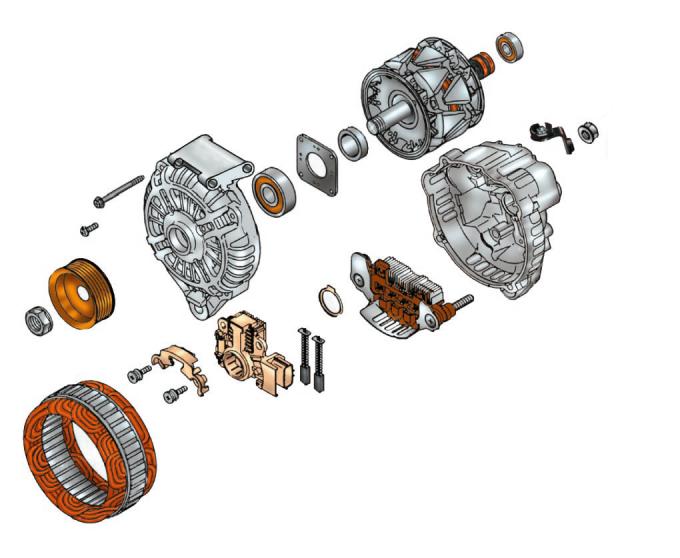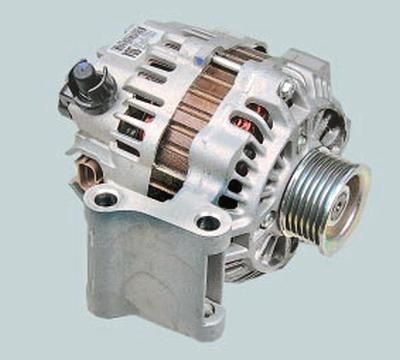
Pic. 10.6. Generator parts: 1 - pulley fastening nut; 2 - pulley; 3 - screw fastening the pressure plate of the front bearing; 4 – a coupling bolt of covers of the generator; 5 - cover from the drive side; 6 - front rotor bearing; 7 - pressure plate of the bearing; 8 - distance ring; 9 - rotor; 10 - contact rings; 11 - rear rotor bearing; 12 – contact bolt nut; 13 – contact bolt terminal; 14 - cover from the side of slip rings; 15 - rectifier block; 16 - sealing gasket; 17 - brushes; 18 - brush holder with voltage regulator; 19 - overlay; 20 - screws for fastening the brush holder; 21 - stator.

Ford Mondeo cars are equipped with three-phase alternators with electromagnetic excitation, with built-in rectifier unit and electronic voltage regulator.
The fan impeller and drive pulley are located on the generator shaft. The shaft is mounted on sealed type bearings that do not require additional lubrication during the entire service life. The shaft is driven from the crankshaft pulley by a V-ribbed belt.
In addition to the electronic regulator built into the generator, the generator's operating modes are also controlled by the electronic engine control unit. It automatically increases the generator output voltage at low ambient temperatures to more efficiently recharge the battery, turns off the generator when the engine is started, and increases the engine idle speed when the generator is heavily electrically loaded. In the event of any malfunctions in the power supply system and when the ignition is switched on with the engine not running, the engine control unit turns on the battery discharge signal lamp.
Lids 5 (pic. 10.6), 14 and stator 21 are tightened with four bolts 4. The rotor shaft 9 rotates in ball bearings of closed type 6 and 11.
The generator stator is equipped with a three-phase winding, made according to the "triangle" scheme (phase windings are attached at three points).
The excitation winding is located on the rotor 9. The excitation winding leads are soldered to two copper slip rings 10 mounted on the rotor shaft 9.
Power is supplied to the excitation winding through two contact brushes 17 and slip rings 10.
Contact brushes are located in the brush holder 18, combined in one housing with a voltage regulator.
The generator connections are shown in the wiring diagrams.
Depending on the engine model, generators of various capacities, but similar in design, can be installed on the car.
NOTE: Codes of emerging faults in the power supply system are stored in the memory of the electronic engine control unit. They can be read using a scanner at the service.
USEFUL ADVICE: Recently, many companies specializing in the repair of imported starters and generators have appeared. There you can diagnose a faulty unit, purchase spare parts for any model of the generator (starter), get qualified advice. If you are not sure you can repair the generator (starter) independently, it makes sense to contact such a company, where the repair of these units will be performed quickly, efficiently and, as a rule, at an affordable price. However, on high mileage vehicles, it is often more cost effective to replace the assembly with a new one than to replace failed parts.
Visitor comments